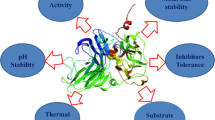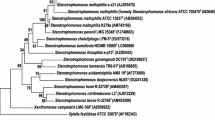Abstract
A novel lipase gene from Aspergillus fumigatus, afl1-1, was cloned and expressed with a molecular mass of 38 kDa in Escherichia coli for the first time. The recombinant lipase had a preference for short carbon chain p-nitrophenyl esters, especially toward C2 p-nitrophenyl ester and exhibited potent hydrolysis activity that had not been observed. The optimum pH and temperature of this new enzyme were 8.5 and 65 °C, respectively. The recombinant lipase (AFL1-1) is an alkaline enzyme which was stable in the pH range 6.0∼8.5 for 16 h (at 4 °C) and at 30∼50 °C for 1 h. It is an intracellular enzyme which was purified approximately 8.47-fold with an overall yield of 86.1% by single-step Ni-NTA affinity purification, with a very high specific activity of approximately 1.00 × 103 U mg−1 on a standard substrate of p-nitrophenyl acetate. The Michaelis–Menten kinetic parameters V max and K m of the lipase were 1.37 mM mg−1 min−1 and 14.0 mM, respectively. Ca2+ and other metal ions could not activate the lipase. According to the homology analysis and site-directed mutagenesis assay, the catalytic triad of the recombinant lipase was identified as Ser-165, Asp-260, and His-290 residues.







Similar content being viewed by others
References
Kim, E. K., Jang, W. H., Ko, J. H., Kang, J. S., Noh, M. J., & Yoo, O. J. (2001). Lipase and its modulator from Pseudomonas sp strain KFCC 10818: proline-to-glutamine substitution at position 112 induces formation of enzymatically active lipase in the absence of the modulator. Journal of Bacteriology, 183, 5937–5941.
Kumar, S. S., & Gupta, R. (2008). An extracellular lipase from Trichosporon asahii MSR 54: medium optimization and enantioselective deacetylation of phenyl ethyl acetate. Process Biochemistry, 43, 1054–1060.
Jaeger, K. E., & Reetz, M. T. (1998). Microbial lipases from versatile tools for biotechnology. Trends in Biotechnology, 16, 396–403.
Gupta, R., Gupta, N., & Rathi, P. (2004). Bacterial lipases: an overview of production, purification and biochemical properties. Applied Microbiology and Biotechnology, 64, 763–781.
Mhetras, N., Bastawde, K., & Gokhale, D. (2009). Purification and characterization of acidic lipase from Aspergillus niger NCIM 1207. Bioresource Technology, 100, 1486–1490.
Yadav, R. P., Saxena, R. K., Gupta, R., & Davidson, S. (1998). Lipase production by Aspergillus and Penicillium species. Folia Microbiologica, 43, 373–378.
Nishizawa, M., Gomi, H., & Kishimoto, F. (1993). Purification and some properties of carboxyl esterase from a Arthrobacter globiformis: stereoselective hydrolysis of ethyl chrysanthemate. Bioscience, Biotechnology, and Biochemistry, 57, 594–598.
Karakousis, A., Tan, L., Ellis, D., Alexiou, H., & Wormald, P. J. (2006). An assessment of the efficiency of fungal DNA extraction methods for maximizing the detection of medically important fungi using PCR. Journal of Microbiological Methods, 65, 38–48.
Wang, Y., Zhao, J., Xu, J.-H., Fan, L.-Q., Li, S.-X., Zhao, L.-L., et al. (2010). Significantly improved expression and biochemical properties of recombinant Serratia marcescens lipase as robust biocatalyst for kinetic resolution of chiral ester. Applied Biochemistry and Biotechnology, 162, 2387–2399.
Becker, P., Abu-Reesh, I., Markossian, S., Antranikian, G., & Markl, H. (1997). Determination of the kinetic parameters during continuous cultivation of the lipase-producing thermophile Bacillus sp. IHI-91 on olive oil. Applied Microbiology Biotechnology, 48, 184–190.
Bradford, M. M. (1976). A rapid and sensitive method for the quantitation of microgram quantities of protein utilizing the principle of protein-dye binding. Analytical Biochemistry, 72, 248–254.
Ahmed, E. H., Raghavendra, T., & Madamwar, D. (2010). An alkaline lipase from organic solvent tolerant Acinetobacter sp. EH28: application for ethyl caprylate synthesis. Bioresource Technology, 101, 3628–3634.
Zhu, X. (2002). Observation of an arsenic adduct in an acetyl esterase crystal structure. Journal of Biological Chemistry, 278, 2008–2014.
Saxena, R. K., Davidson, W. S., Sheoran, A., & Giri, B. (2003). Purification and characterization of an alkaline thermostable lipase from Aspergillus carneus. Process Biochemistry, 39, 239–247.
Hiol, A., Jonzo, M. D., Rugani, N., Druet, D., Sarda, L., & Comeau, L. C. (2000). Purification and characterization of an extracellular lipase from a thermophilic Rhizopus oryzae strain isolated from palm fruit. Enzyme and Microbial Technology, 26, 421–430.
Sharon, C., Nakazato, M., Ogawa, H. I., & Kato, Y. (1998). Lipase-induced hydrolysis of castor oil: effect of various metals. Journal of Industrial Microbiology and Biotechnology, 21, 292–295.
Snellman, E. A., Sullivan, E. R., & Colwell, R. R. (2002). Purification and properties of the extracellular lipase, LipA, of Acinetobacter sp. RAG-1. European Journal of Biochemistry, 269, 5771–5779.
Abbas, H., Hiol, A., Deyris, V., & Comeau, L. (2002). Isolation and characterization of an extracellular lipase from Mucor sp. strain isolated from palm fruit. Enzyme and Microbial Technology, 31, 968–975.
Castro-Ochoa, L. D., Rodriguez-Gomez, C., Valerio-Alfaro, G., & Ros, R. O. (2005). Screening, purification and characterization of the thermoalkalophilic lipase produced by Bacillus thermoleovorans CCR11. Enzyme and Microbial Technology, 37, 648–654.
Chakraborty, K., & Paulraj, R. (2008). Enrichment of eicosapentaenoic acid from sardine oil with delta 5-olefinic bond specific lipase from Bacillus licheniformis MTCC 6824. Journal of Agricultural and Food Chemistry, 56, 1428–1433.
Liu, Y. Y., Xu, J. H., & Hu, Y. (2000). Enhancing effect of Tween-80 on lipase performance in enantioselective hydrolysis of ketoprofen ester. Journal of Molecular Catalysis B-Enzyme, 10, 523–529.
Cardenas, F., de Castro, M. S., Sanchez-Montero, J. M., Sinisterra, J. V., Valmaseda, M., Elson, S. W., et al. (2001). Novel microbial lipases: catalytic activity in reactions in organic media. Enzyme and Microbial Technology, 28, 145–154.
Dandavate, V., Jinjala, J., Keharia, H., & Madamwar, D. (2009). Production, partial purification and characterization of organic solvent tolerant lipase from Burkholderia multivorans V2 and its application for ester synthesis. Bioresource Technology, 100, 3374–3381.
Ollis, D. L., Cheah, E., Cygler, M., Dijkstra, B., Frolow, F., Franken, S. M., et al. (1992). The α/β hydrolase fold. Protein Engineering, 5, 197–211.
Kasrayan, A., Bocola, M., Sandström, A. G., Lavén, G., & Bäckvall, J.-E. (2007). Prediction of the Candida antarctica lipase a protein structure by comparative modeling and site-directed mutagenesis. ChemBioChem, 8, 1409–1415.
Nardini, M., & Dijkstra, B. W. (1999). α/β Hydrolase fold enzymes: the family keeps growing. Current Opinion in Structural Biology, 9, 732–737.
Helm, C., Davis, R. C., Osterlund, T., Schotz, M. C., & Fredrikson, G. (1994). Identification of the active site serine of hormone-sensitive lipase by site-directed mutagenesis. FEBS Letters, 344, 234–238.
Nardini, M., Lang, D. A., Liebeton, K., Jaeger, K. E., & Dijkstra, B. M. (2000). Crystal structure of Pseudomonas aeruginosa lipase in the open conformation—the prototype for family I.1 of bacterial lipases. Journal of Biological Chemistry, 275, 31219–31225.
Acknowledgments
This research was financially supported by China National Special Fund for State Key Laboratory of Bioreactor Engineering (No. 2060204) and Shanghai Leading Academic Discipline Project (No. B505).
Author information
Authors and Affiliations
Corresponding authors
Electronic Supplementary Material
Below is the link to the electronic supplementary material.
ESM 1
(DOCX 214 kb)
Rights and permissions
About this article
Cite this article
Shangguan, JJ., Liu, YQ., Wang, FJ. et al. Expression and Characterization of a Novel Lipase from Aspergillus fumigatus with High Specific Activity. Appl Biochem Biotechnol 165, 949–962 (2011). https://doi.org/10.1007/s12010-011-9311-2
Received:
Accepted:
Published:
Issue Date:
DOI: https://doi.org/10.1007/s12010-011-9311-2




